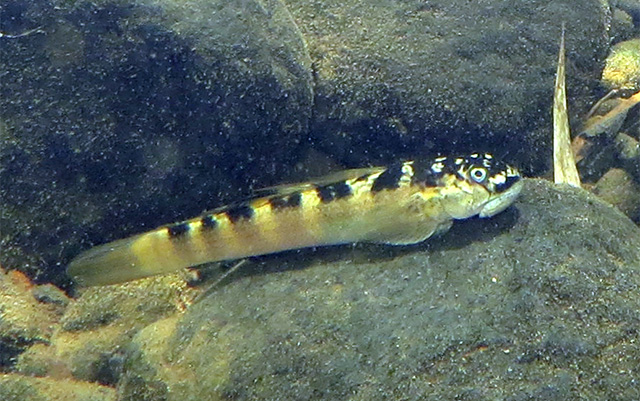| Gobiidae (Gobies), subfamily: Sicydiinae |
| 10.5 cm TL (male/unsexed) |
|
demersal; freshwater, amphidromous |
| Africa: in most drainage basins along the Gulf of Guinea. |
|
Dorsal spines (total): 7; Dorsal soft rays (total): 10; Anal spines: 1; Anal soft rays: 10. Diagnosis: posterior tip of upper jaw extending to below posterior margin of eye or beyond (Ref. 57403), 79590). 63-136 long, slender, unicuspid setiform teeth on each half (left and right) of upper jaw, with alternate teeth usually staggered in 2 rows (although it may be difficult to easily distinguish these rows as separate)(Ref. 79590), not separated by median tubercle (Ref. 57403, 79590).
Description: upper lip smooth, with a median notch but no distinct median tubercle (fleshy swelling); each half of lower jaw usually bears 4-9 caniniform teeth and 40-50 labial teeth (although a single individual that appears to be S. brevifile has 2 caniniform and 35 labial teeth on each half of lower jaw); in adults, anterior labial teeth, attached to opposite halves of lower jaw, separated broadly by a wide projection of soft tissue at dentary symphysis; 17-25 cycloid predorsal scales on nape; 53-66 scales in longitudinal series (including 2-3 scales on caudal fin base); 17-24 scales in rearward transverse series; abdomen covered by cycloid scales; 1st dorsal fin VI, 2nd dorsal fin I-10, anal fin I-10, pectoral fin 18-21 (usually 20 or 21), caudal fin with 17-18 segmented rays, 13-15 of which are branched; preopercular canal incorporating 3 pores (Ref. 79590).
Coloration: Preserved adult specimens: dark brown on body and may be irregularly freckled with small spots (postlarvae and early juveniles may have about 7 faint bars on flanks); cheek and opercle with small speckles and some striations; dorsal fins dark; anal fin faintly speckled except near tips of rays, which are darker; caudal fin dusky, slightly darker along dorsal margin; pectoral fin dusky with 2 vague rows of darkish spots near base, and dark tips to fin rays (Ref. 79590). In life: pelvic fin red at base; caudal fin with reddish/orange bands along posterior and upper margin; anal fin with orange/salmon distal margin (Ref. 79590). |
| Larvae ascend rivers, adults in freshwater (Ref. 4343). Amphidromous endemics living as adults in clearwater streams of the volcanic islands in the Gulf of Guinea and of Mount Cameroon streams in Western Cameroon (Ref. 92840). |
|
Least Concern (LC); Date assessed: 22 May 2013 Ref. (130435)
|
| harmless |
Source and more info: www.fishbase.org. For personal, classroom, and other internal use only. Not for publication.

